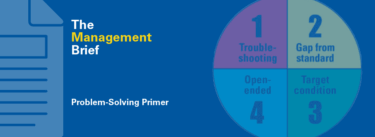Introduction
The four types of problems are:
- Type 1: Troubleshooting: Reactive problem solving that hinges upon quick response and dealing with immediate symptoms of a perceived problem. It provides some immediate relief and problem mitigation but generally fails to get at the actual root cause of a problem and can lead to prolonged cycles of firefighting.
- Type 2: Gap from Standard: Structured problem solving that focuses on specific problem definition, setting goals, root cause analysis, establishment of countermeasures, checks, standards, and follow-up activities. The aim is to prevent the problem from recurring by eliminating its underlying causes.
- Type 3: Target Condition: Continuous improvement (kaizen) that goes beyond existing levels or standards of performance. It seeks to eliminate waste, overburden, unevenness, or other specific concerns systemically. It may utilize existing methods in new creative ways to deliver superior value or performance toward a new target state of improvement.
- Type 4: Open-ended: Innovative problem solving based on creativity, synthesis, and recognition of opportunity. It is open-ended and identifies new problems, solution spaces, or opportunities in ways not previously recognized. It establishes new norms that often entail radical improvements and unexpected products, processes, systems, or value for the customer well beyond current levels.
The problems that confront organizations can be effectively understood through these four types. Some essential elements are common to any problem-solving activity, i.e., grasping facts, identifying desired direction, seeking to understand causality, taking purposeful action that may entail applying a known countermeasure, or experimenting to learn. Capability in all four approaches enables an organization to attain stability, improve and sustain gains, and advance steadily toward its goals and visions. The use of each type is based upon situational logic and specific need.
Read the entire introduction from Four Types of Problems.





